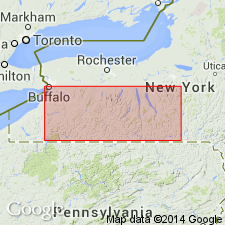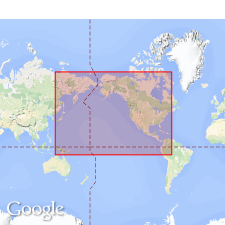
- Usage in publication:
-
- Bluff Point flagstone member
- Modifications:
-
- Original reference
- AAPG geologic province:
-
- Appalachian basin (Eastern Overthrust area)
Summary:
Pg. 16, figs. 6, 7. Bluff Point flagstone member of Standish shale and flags. Thin persistent member of the Standish. Occurs above Crosby sandstone [member]. Age is Late Devonian.
Type locality not stated. Recognized in western and west-central NY.
Source: US geologic names lexicon (USGS Bull. 1200, p. 406).

- Usage in publication:
-
- Bluff Point flagstone
- Modifications:
-
- Overview
- AAPG geologic province:
-
- Appalachian basin (Eastern Overthrust area)
Summary:
Bluff Point flagstone. Name used by P.D. Torrey on a cross section (from Tyrone gas field to Penn Yan, Schuyler, and Yates Counties, New York) on p. 976 of Geol. of nat. gas, AAPG, 1935, for a bed in Standish shale, lying some distance above Crosby sandstone. Not defined.
Source: US geologic names lexicon (USGS Bull. 896, p. 224).

- Usage in publication:
-
- Bluff Point flagstone
- Modifications:
-
- Areal extent
- AAPG geologic province:
-
- Appalachian basin
Summary:
Pg. 2825. Bluff Point flagstone of Torrey and others (1932). Highly cross-laminated ripple-marked layer of siltstone 1 to 2 inches thick is present at base of upper third of West River shale member of Genesee formation in most exposures of member between Lake Erie and Canandaigua Lake. This key bed, which is present in more than 500 sq mi in western and west-central New York, was traced eastward to Keuka Lake where it was found to be the 3- to 4-inch Bluff Point flagstone of Torrey and others (1932), the same bed that was named Keuka flagstone by Fox (1932). Torrey's Bluff Point flagstone is present as far east as Plum Point Creek, 0.5 mile west of village of Himrod, where it is 2.5 feet above top of Ithaca member of Genesee. Thick-bedded fossiliferous siltstones at top of Ithaca member near Ithaca are at approximately same stratigraphic position as Torrey's Bluff Point flagstone. Age is Late Devonian.
[Recognized in Ontario, Steuben, Yates, and Schuyler Cos., western and west-central NY.]
Source: Publication; US geologic names lexicon (USGS Bull. 1200, p. 406).

- Usage in publication:
-
- Bluff Point siltstone bed*
- Modifications:
-
- Adopted
- AAPG geologic province:
-
- Appalachian basin
Summary:
Bluff Point siltstone bed of West River shale member of Genesee formation. The USGS currently [ca. 1960] classifies the Bluff Point siltstone as a bed in the West River shale member of the Genesee formation on the basis of a study now in progress. Recognized in western and west-central New York. Age is Late Devonian.
Source: Publication; US geologic names lexicon (USGS Bull. 1200, p. 406).
For more information, please contact Nancy Stamm, Geologic Names Committee Secretary.
Asterisk (*) indicates published by U.S. Geological Survey authors.
"No current usage" (†) implies that a name has been abandoned or has fallen into disuse. Former usage and, if known, replacement name given in parentheses ( ).
Slash (/) indicates name conflicts with nomenclatural guidelines (CSN, 1933; ACSN, 1961, 1970; NACSN, 1983, 2005, 2021). May be explained within brackets ([ ]).

